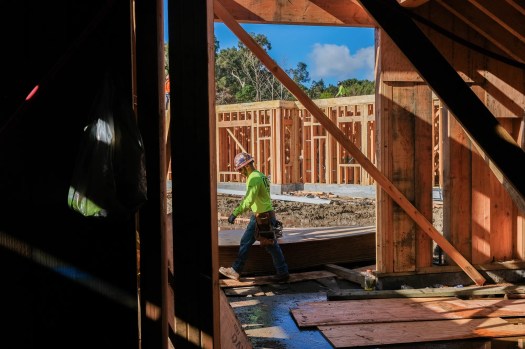When you imagine a renter of
affordable housing,
Christopher McCormick is probably not who comes to mind.
The 38-year-old software developer was on his way to work in early 2020 when he passed an affordable apartment building under construction in Emeryville. He was surprised to find that his annual income — $79,400 — qualified him for a below-market-rate one-bedroom unit. The rent was just $2,100 a month — nearly $600 less than similar market-rate apartments. He entered the lottery and, a few months later, moved in.
McCormick’s moderate-income apartment is part of California’s effort to keep its middle class from moving away. The state has a goal to build 2.6 million new units by 2032 to meet demand and keep costs from further ballooning. Of those, 420,800 are meant to be affordable to moderate-income households, who make between 80% and 120% of the area median income — for a family of four, between $125,050 and $191,750 in Alameda County, and $159,550 and $234,250 in Santa Clara County.
For the most part, the market doesn’t build this kind of housing — which is why the state and local governments provide incentives to developers, such as allowing more density or less parking if they include below-market-rate units. Middle-income housing doesn’t qualify for the same property tax exemptions that low-income housing does.
Still, five years into its plan, developers in California have built only 22,316 moderate-income units. With high interest rates and rents
not growing as some predicted
, they say they need more incentives for this type of housing to pencil out financially.
But there’s disagreement on where government should intervene: Should it encourage more middle-income homes for people to rent, or to own?
The answer, most housing experts would agree, is both. California needs more of all types of housing to climb its way out of its deep affordability crisis.
Developers tend to favor building rental housing in high-cost areas because it offers steadier cash flow, lower legal risk, and stronger demand from renters who can’t afford to buy. Moderate-income housing policy has followed this status quo, largely focusing on renters. Still, even generating support for rental housing incentives has proved an uphill battle.
Two bills this legislative session sought to offer tax breaks for middle-income housing. The first,
SB 336
from San Francisco Democratic Sen. Scott Wiener, would have extended a property tax exemption to buildings with units set aside for such renters — a benefit currently reserved for developers serving lower-income renters. On the for-sale side,
AB 595
, proposed by Democratic Assemblyman Juan Carrillo of Palmdale, would have created a new tax credit for home builders constructing income-restricted homes.
Both bills died. As California faces a
$12 billion budget shortfall
, legislators balked at most measures that might drain city or state coffers.
But the ideas aren’t going away. A version of SB 336 has appeared before the Legislature almost every year since 2019. Many of its backers say it’s the kind of structural fix that will help build moderate-income housing at scale.
One of the major backers, unsurprisingly, is a Bay Area developer — Enrique Landa.
His company, Associate Capital, is leading a major redevelopment of the
29-acre Potrero Power Station
along San Francisco’s waterfront, which will include 2,600 new homes — a third of them at below-market rents. The first building is set to open this fall, with all 105 apartments reserved for moderate-income renters.
“We were only able to do this because we had a larger project that was able to cross-subsidize this effort,” Landa said at a Senate hearing in May. “This wasn’t a replicable path — but with this legislation, it could be.”
But there’s a question of whether moderate-income housing offers enough of a discount to justify a major tax exemption.
A recent
Bay Area News Group investigation
found that outside of extremely high-cost areas, such as San Mateo County and San Francisco, moderate-income units don’t always provide a meaningful discount to market rates. Notably, 7% of the moderate-income housing units built in recent years around the Bay Area are vacant — double the vacancy for units targeted at renters making below 80% of the area median income.
Rich Wallach, an affordable housing developer with Burbank Housing in Santa Rosa, said it’s critical that any policy that would subsidize moderate-income housing include a provision that rents provide a significant discount.
“The trick to not having vacant units sit is to undercut the market — not be at market,” Wallach said.
But other housing activists suspect there’s something else at play that explains the somewhat higher vacancy at moderate-income units:
an exodus to lower-cost regions
.
“Moderate-income families may reach a point in struggling with housing affordability where they just decide to leave the region,” said Adam Briones, CEO of California Community Builders, which advocates for access to homeownership. “These are people who want to buy a home, and they absolutely cannot do it in the Bay Area.”
That’s eventually what happened for McCormick, the Emeryville renter.
“I was giving someone else money without building equity myself,” McCormick said.
When he looked into below-market-rate for-sale housing, he found a few options in Emeryville — most were condos, and with the homeowners association fee tacked onto a monthly mortgage payment, plus property taxes, he would have had to pay around $3,200 a month. It was more than he felt he could comfortably afford.
So McCormick bought a house in the suburbs — of Pittsburgh, Pennsylvania. For his $310,000, five-bedroom house, he pays a monthly mortgage of $2,800.
Briones sees stories like McCormick’s as evidence the state needs to do more to help people buy — not just rent.
“For a rental, the landlord retains the economic benefit,” Briones said. “If we subsidize units for a homeowner, that helps to create generational wealth for a moderate-income household.”
Rental housing has been the focus of most federal subsidies since at least 1961, when the federal government created the
Below Market Interest Rate Program
to provide low-interest loans for multifamily rental developers in exchange for affordability restrictions. The focus was further entrenched when former President Ronald Reagan created the
Low-Income Housing Tax Credit
in 1986, which provided tax incentives to private developers building affordable housing. The program is still the primary tool for financing new affordable housing throughout the country.
But before that, policymakers were thinking of ways to subsidize for-sale product. In 1955, New York passed the
Mitchell-Lama program
, which allowed for the creation of limited-profit housing companies. These companies could get low-interest-rate financing to cover up to 95% of a project’s cost, plus major property tax breaks, which allowed developers to build housing middle-income New Yorkers could afford. In return for the incentives, developers were limited to a 6% profit on dividends (later increased to 7% in 1969.) The program produced over 130,000 units in New York City alone—half of them for-sale.
Today, it’d be unimaginable for developers to envision a mere 6% return. In 2023, homebuilders reported an
average gross profit margin of 20.7% in 2023
, according to the National Association of Homebuilders.
Alex Schafran, a housing policy researcher, said there are benefits to both renting and owning — but that right now the Bay Area’s middle-income households are relegated to the rental market, because home-buying is only possible for the highest earners.
“But everyone should have a real choice,” he said. “Regardless of income.”

